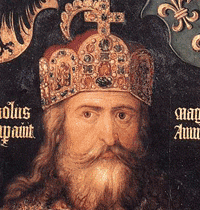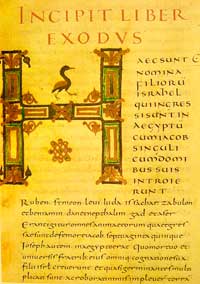| 8th Century | The Roman Letterform is Revived by the Carolingians | |||
 |
|
 3 |
 Gospel St. Matthew (see larger) 8 Gospel St. Matthew (see larger) 8 |
| Emperor Charlemagne After the fall of the Roman Empire, the end of a central advanced culture resulted in general illiteracy and a breakdown of handwriting into diverse regional styles. For 300 years the knowledge of writing was kept alive mainly in the remote outposts of religious cloisters and retreats. In the eighth century Emperor Charlemagne came to rule over the vast and powerful Frankish kingdom. Government became more organized and under cultural stabilization the arts could begin to flourish again. Romanesque architecture and writing styles reemerged through the medium of the Catholic church. Charlemagne, though only partially literate, supported the restoration and correction of religious texts and classical works. In 789 he "ordered a revision of the books of the church. He did not evidently intend any textual revision; instead he wanted the most beautiful and accurate copies made of finest existing manuscripts." 1 |
Carolingian Minuscule A court school was established under the direction of Alcuin of York. During Charlemagne's patronage book production increased and language was standardized —pronunciation and spelling as well as writing conventions— capitals at the start of a sentence, spaces between words and punctuation. A new script emerged, the Carolingian minuscule. Originally attributed to Alcuin, it now is believed that he was not directly responsible for the face, but in fact it a style that developed in various locations over time. (Nevertheless there is a font named Alcuin by Gudrun Zapf- Von Hesse). Contemporary scholars attribute Maurdramnus, the abbot of Corbie from 772–781, with the fully realized version of the script. His clear and distinct letterform design was based upon studies of classical letterforms from ancient Rome. The compact form was not only legible, it used less material. |
Carolingian Minuscule, 9/10th C The Carolingian minuscule, was used for all legal and literary works to unify communication between the various regions of the expanding European empire. Alexander Nesbitt writes of the importance of this letterform development; The minuscule was developed from uncials and half-uncials, exploiting the Roman characteristics of rounded, open and clean forms, uniformity, and above all, legibility.
Because both ligatures and abbreviations were avoided each letter became a fully realized and independent form. |
Centuries later, it would make the jump to moveable type easier. The Carlovingian minuscule was as important a development as the standard Roman capital—for it was this style that became the pattern for the Humanistic writing of the fifteenth century; this latter, in turn was the basis of our lower-case roman type. 4 |
|
A page from the Grandval Bible (right) displays a progression of older to newer scripts in hierarchical order; capitals, uncials and the Carolingian Minuscule. 5 See it at a larger size here. |
 |
||
| Nesbitt on the Roman and Arabic Numbering Systems | |||
| I, II, II, IV | |||
| Arabic Numerals “Although all of our letters are the result of a long and peculiar evolution from Roman writing styles, our numerals come from another source all together: the culture of Islam. |
The Romans had a system of numbering ...certain capital letters I, M, V, X etc. used in arrangements to denote quantities. If one delves into the history of mathematics, one finds that much of the early searching was for a system of numbers that would work easily and well under all conditions. What was really sought was the zero....the focal point of mathematics moved from place to place over time From Egypt to Greece to Rome to India, where mathematicians finally found the use of zero—at about the 6th century. 6 |
Exactly how the indian system came to the Arabs is uncertain, in any event the Arab world became the next dominance in mathematic and the numbers were named accordingly. Western Europe learned these numbers from the Moors in Spain and later during the Crusades. By the 13th century Arabic numbers came into common usage.” 7 |
|
| Bibliography | |||
1 2,3 |
4
|
7 8
|
|
| Copyrights | |||
| ©Designhistory.org 2011 | |||

